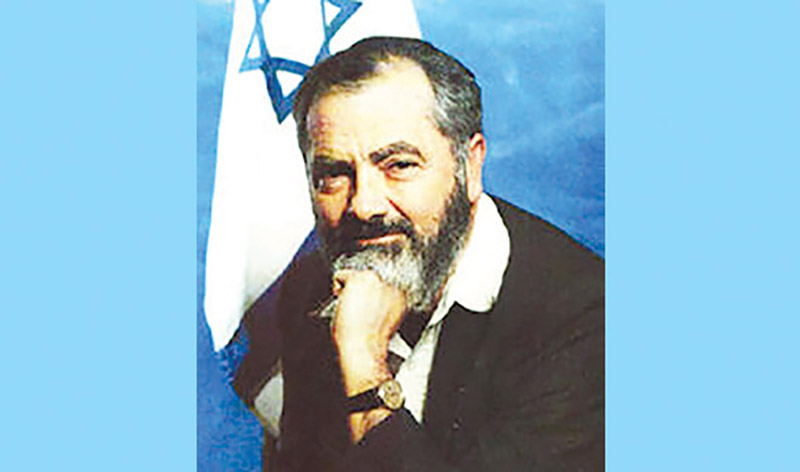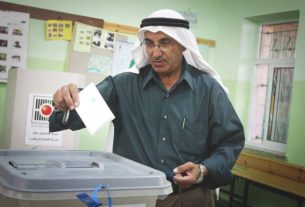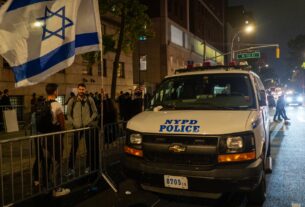Michael ben Horin, a longtime activist in Gush Emunim and the Kach Movement, has been arrested numerous times for protesting Israeli withdrawals from the Sinai desert and Judea and Samaria. He was Kach’s general secretary while Rabbi Meir Kahane was in the Knesset and is the editor of the controversial Baruch HaGever.
Ben Horin is also the father of 12 children and cultivates hadasim on the moshav of Nov in the Golan Heights. The Jewish Press recently spoke with him in honor of the 29thyahrzeit of Rabbi Kahane, which falls out on Shabbos.
‘);
_avp.push({ tagid: article_top_ad_tagid, alias: ‘/’, type: ‘banner’, zid: ThisAdID, pid: 16, onscroll: 0 });
The Jewish Press: Do you still believe Rabbi Kahane was right?
Ben Horin: Today, the healthy majority of the nation sees with their own eyes how right he was. Look at the election mess we have to suffer because of the Arab parties. Without them, the political right comprises nearly 60 percent of the voters in Israel.
How absurd that a platform based on the destruction of Israel is allowed expression in the Knesset. This tragic situation is what stands in the way of forming a stable rightest government.
A decade ago, you designed and distributed 1,000 medallions with the words: “Kahane Tzedak” – “Kahane was Right.” Why?
When a person believes in the value of an idea, it is proper to publicize it so that others can benefit as well. This is especially true when the idea, is endlessly hounded, as the verse states: “And G-d will stand up for the persecuted” (Kohelet 3:15).
What attracted you to Rabbi Kahane?
Rav Meir Kahane was the only clear Jewish voice in the political arena. Everyone else stuttered, while Rav Kahane spoke the truth without fear. He used to say, “I state openly the things you feel in your heart.” That’s why opponents hated him, because he made them look shallow – both the leaders of the political Right and those of the Left.
They all fought against him with all of their strength – with the full support of the judicial system, police, army echelon, Shabak, and media – in order to derail his gaining popularity and the political strength of his party.
What issues most provoked their wrath against him?
Rav Kahane raised a banner against the Bolshevistic rule of the courts and against the criminal past of the government in kidnapping Yemenite children. Time and again, he underscored the disdain and lack of allegiance that the country’s Arabs feel toward Medinat Yisrael, warning that the Knesset’s cherished idol of democracy could lead Herzl’s dream into becoming an Arab state.
For him, promoting these truths was the true ahavat Yisrael. Whenever people called him a racist, he would answer, “I don’t hate Arabs – I love Jews.” Never did you hear Rav Kahane or the Kach Party say: “Death to Arabs!” Rather, the chant was, “Arabs must go!” For him, the “right of return” meant: Jews return to Zion, and Arabs to Arab states.
In your opinion, what made Rabbi Kahane such a passionate Zionist?
No doubt, he had the soul of some great Jewish hero from Biblical days. On a more down-to-earth level, his great-grandfather made aliyah from Europe at the behest of the Admor of Sanz. Because the times were rampant with famine, earthquakes, and plagues, the family moved to America, where Rav Kahane was born.
Rav Kahane received a passionate Zionist education. Many Jews in his era had similar backgrounds, but not everyone became a passionate Jewish leader. Rav Kahane had a special soul. He was a prophet in our time.
In retrospect, could he have perhaps accomplished more if he had joined the Likud Party when he moved to Israel rather than formed his own party?
That would be like asking a lion to shave off his mane and join a group of pussycats. When Rav Kahane came on aliyah, he was famous for establishing the Jewish Defense League in America and for initiating the struggle to free Soviet Jews. The Herut-Likud Party immediately invited him to join their faction. He knew they wanted to use his popularity for themselves while tying his hands and gagging his mouth. So he turned them down and formed his own party.
Wouldn’t you know? Who was the future leader of the campaign to ban him from the Knesset? The Likud and Yitzhak Shamir, the famous underground warrior of Lechi in the days where Jews weren’t afraid to be Jews. With the help of other old underground fighters, like Geula Cohen of the Techiya Party, along with the champions of Hellenism on the Left, and the “legal” backing of Meir Shamgar’s supreme court of tyranny, Rav Kahane was thrown out of the Knesset while the Arabs were allowed to remain, up until today, even though they support terrorism against Jews and long for the end of the Jewish state.
How did you meet Rabbi Kahane?
When Menachem Begin became prime minister, he turned his back on the people who voted for him and decided to give away the entire Sinai to Egypt. When Sadat was invited to Jerusalem, I understood that a huge betrayal was on the way. In World War II, Sadat worked with the Nazis, and the British imprisoned him for that in Cairo. In his meeting with Begin, he wore a necktie with a symbol of a swastika woven into the design.
As stipulated in the 1979 treaty, Israel was required, within three years, to withdraw all of its 2,500 civilians and thousands of military personnel from the Sinai, which it had captured in the Six-Day War. Rav Yisrael Ariel and his brother, Rav Yaacov, were the heads of the mixed religious and secular community in Yamit. On the day the Knesset voted in favor of the peace deal with Egypt, I accepted their invitation to illegally establish a dati settlement in northern Sinai, what later turned into Atzmona.
In 1980, Rav Yisraeli informed me that in order to stop the withdrawal from the Sinai, he was joining Rav Kahane in his bid for the Knesset. He assigned me the fifth spot on the ticket. In the autumn of 1981, when he asked me to form another yishuv in the Sinai to strengthen the Jewish presence in the area, I found myself working alongside Baruch Marzel, a close follower of Rav Kahane.
I first met Rav Kahane outside the “bunker” in Yamit where a group of ardent Kahanists announced that they were prepared to resist the pending army evacuation even if it meant sacrificing their lives. My assignment as a trained engineer was to fortify the bunker in the best possible manner. Supplied with explosives, the group of idealists, threatened to blow themselves up if Tzahal attempted to remove them by force.
Finally, prior to the showdown, Rav Kahane persuaded them to abandon their highly-publicized suicide plan.
After the withdrawal from Sinai, you were appointed to the secretariat of the Kach party. How was Rabbi Kahane received in the Knesset?
A campaign of hatred and incitement was waged against him. The president of the country, Chaim Herzog, refused to meet with him. The media officially boycotted him. They didn’t afford him a chance to explain his actions and beliefs.
When he spoke before the Knesset, in speeches filled with inspiration, Jewish pride, and vision, Knesset members from all parties would flee from the auditorium. In response, he would begin his remarks, “To the honorable head of the Knesset and to the empty assembly hall….”
Did he express frustration, disappointment, or anger in response to the way he was treated?
Most often, he laughed it off. He was like a giant pestered by flies. He felt frustration and anger because of the weak-hearted spirit of the nation’s leaders, and for the honor of the Torah which his perspectives represented, but he didn’t react to the abuse on a personal level. To the chagrin of the elitists, their strategy boomeranged. The healthy Jewish populace sensed that a true Jewish leader had arisen.
Thousands attended Kach rallies all over the country whenever Rav Kahane appeared. Before the next election, a reliable survey had him winning 13 seats. Trembling with fear, in the name of democracy, the Stalinist establishment banned Kach from the Knesset.
You’re the editor of Baruch HaGever, which is a tribute to Dr. Baruch Goldstein, who killed 29 Arabs in Me’arat Hamachpelah in 1994. Before getting to the deed itself, how did you know him?
In 1988, Rav Kahane appointed Baruch to his election committee. Since I was a possible candidate for the list, Baruch asked me if I would be loyal to the rav. Before I could answer, Rav Kahane said, “Not loyal to me – loyal to the Jewish Idea.”
On another occasion, after I established the Medinat Yehuda Movement and traveled throughout Yesha to enlist followers, Dr. Baruch invited me to his medical clinic in Kiryat Arba for a meeting. He showed me the Trauma Room that he had created, equipped with the most modern life-saving equipment.
After his heroic action in saving the Jewish community of Hevron in 1994, the media and political establishment tried to portray him as a wild and crazy individual. But the very opposite was true. He was as calm and decisive as a surgeon and an expert in emergency medicine who had saved the lives of both Arabs and Jews on numerous occasions. He was a graduate of Flatbush Yeshiva, Yeshiva University, and the Albert Einstein Medical School – a figure worthy of emulation.
The Israeli mainstream vilified him for what he did. What made you decide to publish Baruch HaGever, which is filled with his praises?
The Shamgar Commission – the official government investigation into the “Massacre in the Tomb of the Patriarchs” – clearly stated that on the very same morning [that Goldstein shot 29 Arabs], the Arabs of Hevron were planning to massacre Jews.
The military authorities knew this, and they explicitly told Dr. Baruch to be prepared to treat the casualties. Dr. Baruch beat the Arabs to the punch. On Purim morning, an hour before the planned terror attack on the Jews, he entered the Tomb and started to fire at the Arabs who were praying there.
If the IDF knew in advance about the planned Arab attack against the Jews of Hevron, why didn’t it do anything to stop it?
In my opinion, Prime Minister Yitzhak Rabin wanted the attack to occur. That way, in the aftermath, he could remove all the Jews from Hevron and Kiryat Arba on the pretense that Tzahal couldn’t protect them.
On the day after Dr. Goldstein was buried, anticipating the avalanche of vilification that his name and his family was about to suffer, I went to the Kach office in Jerusalem to write and print out a flyer in his honor…. A local newspaper in the Golan then asked me to write about him, so I started collecting recollections from the residents of Kiryat Arba.
When Rabin pushed through a bill to evacuate the settlers of Tel Rumeida on the hillside of Hevron, Baruch Marzel’s wife phoned me and asked me to help. When I arrived in Kiryat Arba, I was arrested and put under administrative detention with 10 others for six months. During the time I was incarcerated, I continued collecting articles of praise and divrei Torah about Dr. Goldstein. With the assistance of friends, I managed to foil attempts by the Shabak to confiscate the book and sent it to the printer.
You must have known that publishing a book filled with praise for someone who was termed a mass murderer was going to raise the ire of the law.
Of course. I told my wife that I was ready to sit a few years in jail for the honor. After all, Baruch gave his life to save the Jews of Hevron. In the end, I got off cheap. I was sentenced to eight months in the lower court, but when we took the case to the Supreme Court, I was given a half year of public service outside of prison.
‘);
_avp.push({ tagid: article_top_ad_tagid, alias: ‘/’, type: ‘banner’, zid: ThisAdID, pid: 16, onscroll: 25 });




